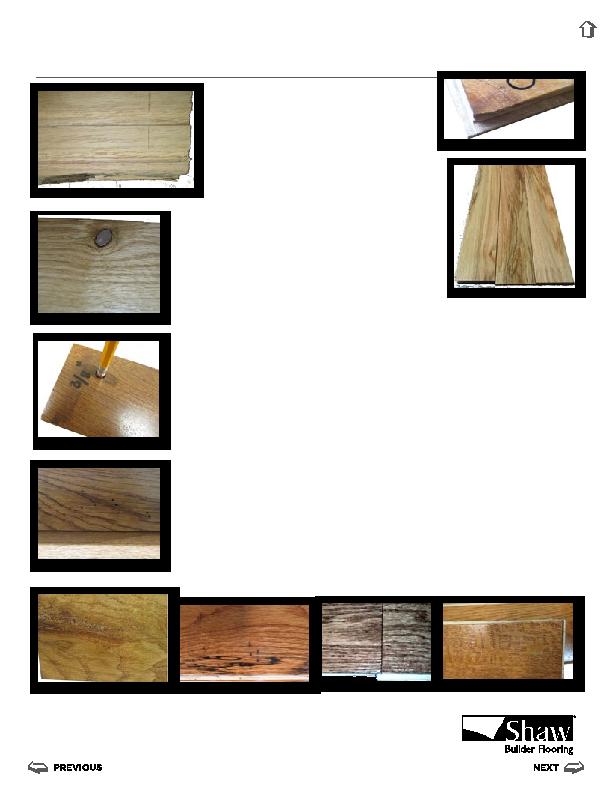
shawbuilderflooring.com
07.28.2016
UNDERSTANDING CHARACTERISTICS OF
SOLID HARDWOOD FLOORS
Grading for hardwood that falls within Shaw's "Rustic" or
"High Variation" visual category which means that the
product can include moderate to high amounts of
color variation. Additionally, sound natural variations of
the forest product and manufacturing imperfections
including but not limited to: bark pockets, broken
edge/broken corner, indentation, splits, machining
imperfections, worm holes filled and unfilled, torn grain,
mineral streaks in unlimited amounts, knots, unfilled
character up to 3/8 of an inch, stick stain, Missing or shy
tongue up to ¼ normal size, sound rot, water marks and
bottom of the board defects that do not make the wear
layer unsound are allowed in the grade. Some, all or none
of the characteristics' will be represented in the sample or
room scene so it will be up to the sales person to insure
the dealers understand what they are ordering. Also, the
Product may contain varying degrees of naturally occurring
wood characteristics commonly found in the No. 2 Common
and Better Grade characteristics based on NOFMA
unfinished Official Flooring Grading Rules (Sept. '02).
A wide range of variation in visual related attributes such
as texture, grain, color, mineral, and naturally occurring
character is allowed in these hardwoods. Variations in grain
can be expected in the form of the direction of wood fibers,
as in straight, spiral and curly grain. The direction of the grain, as well as the amount
of figuring in the wood affects the way wood accepts stains and finishes. There can
be pronounced differentiations in color between spring wood and summer wood or
heartwood and sapwood as well. All of these naturally occurring phenomenon will affect
the way
the wood accepts stains and finishes which can result in a wide range of variability in
finished appearance.
The following are not permitted in the grade: Large broken knots, advanced rot, or large
unsound defects greater than the 5% industry accepted cull rate.
Dealers, installers, and consumers must understand the naturally occurring variation
within these hardwoods as no two planks are identical, no two boxes of finished product
are identical, and no two production populations are identical. The production process is
designed to yield what the forest provides, and consumers can expect clear populations
or character populations or mixed character populations when choosing these solids.
Installers must rely on job site planning, material observation, and craftsmanship to
ensure a successful installation of solid hardwood flooring. Installers must give careful
consideration to naturally occurring characteristics as the installation is planned and the
floor is dry racked. Further, installers should work out of at least six boxes at a time, and
pre-planned dry racking should take into consideration the naturally occurring variation
of the grade. Successful installation of natural wood relies on a complete understanding
of the grade, and pride in craftsmanship.
It would be advantageous from a sales and support standpoint to ensure that customers
are aware of these naturally occurring variations, especially if it is not evidenced well or
at all in their representative sample. There is no means by which to order this product
without this variation as it is simply indigenous to the grade.
Filled Character
Shy Tongue
Rot
Missing Tongue
Bark Pocket
Broken
Corner
Mineral & Stain
Wormholes
Unfilled Character
Bottom of Board Defect

